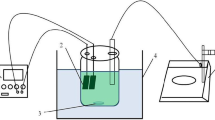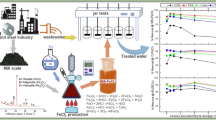Abstract
Iron solubilities in spent pickling (HF-HNO3-H2O) solutions were determined as a function of HF and HNO3 acid concentrations. A chemical analysis of the industrial pickling solutions and sludges was performed. The stable phases observed in the sludges are FeF3·3H2O and (FeCr)F3·3H2O. Pure Fe metal, AISI 316 stainless steel and AISI 416 stainless steel were used in this study. The results show that the solubility of Fe increased as the concentrations of HF increased in the pickling solution at a fixed concentration of HNO3. A reasonable agreement between the experimental solubility data and the theoretical calculated data was obtained. X-ray diffraction analysis showed that the solid solubility product formed in the ternary solution containing pure Fe is mainly at a high pH value, FeO(OH) compounds and, at a low pH value, FeF33H2O compounds.
Similar content being viewed by others
References
American Iron and Steel Institute, 1982, “Cleaning and descaling stainless steels,” A Designers’ Handbook Series: SS 103-582-10M-GP, Washington, D.C., pp. 5–11.
Cole, H.S., 1974, “Corrosion of austenitic stainless steel alloys due to HNO3-H2O mixtures,” ICP-1036, Allied Chemical Corp., 42 pp.
Covino, B.S., Jr., et al., 1986, “Dissolution behavior of 304 stainless steel in HNO3-H2O mixtures,” Metallurgical Transactions A, Vol. 17A, pp. 137–149.
Fernando, L.A., 1990, “Solution chemistry of HNO3/HF pickle mixtures,” Metallurgical Transactions B, Vol. 21B, pp. 5–9.
Hughes, M.A., and Sunghou, H., 1986, “Equilibria in the system cobalt/di-2-ethylhexylphosphoric acid/water,” Journal of Chemical Engineering Data, Vol. 31, pp. 4–11.
Pitzer, K.S., 1979, Activity Coefficients of Electrolyte, R.M. Pytkowicz, ed., CRC Press, Boca Raton, FL, p. 157.
Stephenson, B., Hogan, J.C., and Kaplan, R.S., 1984, “Recycling and metal recovery technology for stainless steel pickling liquors,” Environmental Programming, Vol. 3, No. 1, pp. 50–53.
Vicentini, B., and Bombara, G., 1968, “Mechanism of scale removal in the acid pickling of austenitic stainless steels,” Electrochemical Metallurgy, Vol. 3, pp. 313–322.
Wall, F.T., 1974, Chemical Thermodynamics, 3rd ed., W.H. Freeman and Co., pp. 463–478.
Wang, S., 1992, “Thermodynamic studies on HF-HNO3-H2O solutions containing iron, chromium and nickel”, M.S. Thesis, University of Nevada — Reno, Reno, NV.
Wilson, A.S., and Taube, H., 1952, “The affinities of chromic iron and gallium ion for fluoride ion,” Journal of the American Chemical Society, Vol. 74, pp. 3509–3512.
Zemaitis, J.F., Jr., et al., 1986, Handbook of Aqueous Electrolyte Thermodynamics, AIChE, New York, p. 726.
Author information
Authors and Affiliations
Additional information
SME nonmeeting paper 92-639.
Discussion of this peer-reviewed and approved paper is invited and must be submitted, in duplicate, prior to Aug. 31, 1993.
Rights and permissions
About this article
Cite this article
Reddy, R.G., Wang, S. & Chen, B. Solubility of iron in spent pickling solutions. Mining, Metallurgy & Exploration 10, 102–107 (1993). https://doi.org/10.1007/BF03403009
Received:
Published:
Issue Date:
DOI: https://doi.org/10.1007/BF03403009




